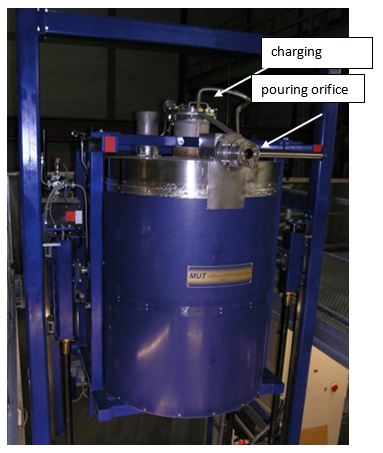Heating Furnace
The melt is prepared in an external heating furnace designed to generate the simulant melt. The cylindrical furnace is 0.58 m in diameter and 1 m in height, and has a volume of 270 liter. The maximum temperature that can be reached to 900° C. Solid nitrate particles are charged in at the top of the furnace, and are gradually melt and heated up to a designed melt pour temperature, which can be kept till a test begins. The impurities inside the solid nitrate salt are burnout during the heating process. The heating furnace is hold by a framework which can be driven in axial direction and be tilted. The pouring operation is started by tilting the heating furnace. Melt is discharged into the test vessel via a heated pouring spout. In addition, the heating furnace is equipped with a vacuum pump, so it is possible to extract the residual liquid melt out of the test vessel back into the heating furnace. The already purified melt can be reused for the next experiment. In addition, the crust inside the test vessel is uncovered after extraction of liquid melt, and is therefore available for the post-test measurement and analysis.
Literature:
Gaus-Liu, X. (2019). Impact of vessel geometry and boundary condition on the heat transfer of liquid corium in LWR lower head. Paper presented at the 27th International Conference on Nuclear Engineering: Nuclear Power Saves the World!, ICONE 2019; Tsukuba International Congress CenterTsukuba, Ibaraki; Japan; 19 May 2019 through 24 May 201.
Gaus-Liu, X., Cron, T., & Fluhrer, B. (2020). Experimental Studies on Two-Layer Corium Heat Transfer in Light Water Reactor Lower Head in LIVE2D Facility. Nuclear Technology, 1-12. doi:10.1080/00295450.2020.1743102
Gaus-Liu, X., Miassoedov, A., Foit, J., Cron, T., Kretzschmar, F., Palagin, A., . . . Schmidt-Stiefel, S. (2013). LIVE-L4 and LIVE-L5L experiments on melt pool and crust behavior in lower head of reactor pressure vessel. Nuclear Technology, 181, 216-226.
Miassoedov, A., Gaus-Liu, X., & Cron, T. (2016). Study of melt formation and behavior of a two-component debris bed in LIVE facility. Transactions of the American Nuclear Society, 115, 865-868.
Seiler, J. M., Ratel, G., Combeau, H., Gaus-Liu, X., Kretzschmar, F., & Miassoedov, A. (2014). Transient refractory material dissolution by a volumetrically-heated melt. Nuclear Engineering and Design, 280, 420-428. doi:10.1016/j.nucengdes.2014.09.025

